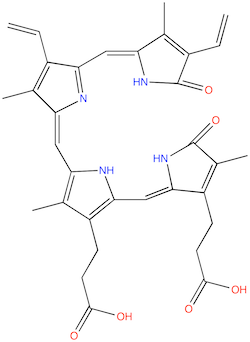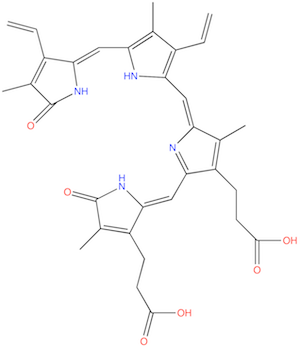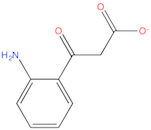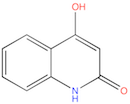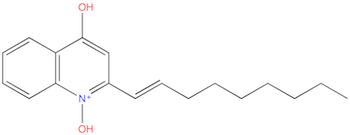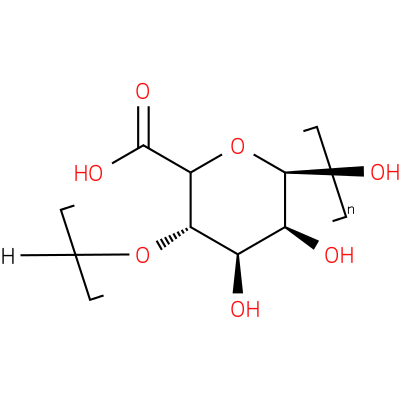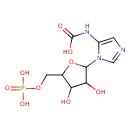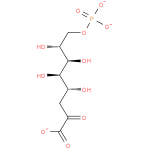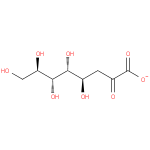
Search Results for compounds
Searching compounds for
returned 4373 results.
Displaying compounds 3061 - 3070 of
4373 in total
Beta Biliverdin (PAMDB100089)
IUPAC:
3-[(2Z)-2-[[3-(2-carboxyethyl)-5-[(E)-[(5E)-3-ethenyl-5-[(4-ethenyl-3-methyl-5-oxopyrrol-2-yl)methylidene]-4-methylpyrrol-2-ylidene]methyl]-4-methyl-1H-pyrrol-2-yl]methylidene]-4-methyl-5-oxopyrrol-3-yl]propanoic acid
CAS: 70695-22-6
Description: Product of oxidative heme degradation produced by Pseudomonas aeruginosa. Produced via the catalytic activity of the Pseudomonas aeruginosa heme oxygenase (paHO) . Catalytic oxidative cleavage of heme to beta biliverdin by paHO facilitates the acquisition of iron by P. aeruginosa, and protects against redox-active "free heme."
Delta Biliverdin (PAMDB100090)
IUPAC:
3-[(5Z)-2-[[3-(2-carboxyethyl)-4-methyl-5-oxopyrrol-2-yl]methylidene]-5-[[3-ethenyl-5-[(Z)-(3-ethenyl-4-methyl-5-oxopyrrol-2-ylidene)methyl]-4-methyl-1H-pyrrol-2-yl]methylidene]-4-methylpyrrol-3-yl]propanoic acid
CAS: Not Available
Description: Product of oxidative heme degradation produced by Pseudomonas aeruginosa. Produced via the catalytic activity of the Pseudomonas aeruginosa heme oxygenase (paHO) . Catalytic oxidative cleavage of heme to beta biliverdin by paHO facilitates the acquisition of iron by P. aeruginosa, and protects against redox-active "free heme."
Anthraniloyl-CoA (PAMDB100091)
IUPAC:
3'-phosphoadenosine 5'-{3-[(3R)-4-{[3-({2-[(2-aminobenzoyl)sulfanyl]ethyl}amino)-3-oxopropyl]amino}-3-hydroxy-2,2-dimethyl-4-oxobutyl] dihydrogen diphosphate}
CAS: Not Available
Description: An acyl-CoA(4-) that is the tetra-anion of anthraniloyl-CoA arising from deprotonation of phosphate and diphosphate functions. Pre-requisite molecule utilized in the formation of all Pseudomonas aeruginosa alkyl-quinolone species.
2-aminobenzoylacetate (PAMDB100092)
IUPAC:
3-(2-aminophenyl)-3-oxopropanoate
CAS: Not Available
Description: Intermediate product in the production of the alkylquinolone products, HHQ, PQS, and DHQ.
DHQ (PAMDB100093)
IUPAC:
4-hydroxy-1H-quinolin-2-one
CAS: 86-95-3
Description:
Extracellular metabolite produced by the pqs operon in Pseudomonas aeruginosa. DHQ is the most abundant alkylquinolone species produced by the P. aeruginosa PQS biosynthetic pathway and may play a distinct role in maintaining P.aeruginosa pathogenicity.
1-hydroxy-2-nonenyl-1,4-dihydroquinolin-4-one (PAMDB100094)
IUPAC:
Not Available
CAS: Not Available
Description: Alkyl-quinolone molecule produced by Pseudomonas aeruginosa. Possesses a mono-unsaturated alkyl chain, and
alginate (PAMDB100095)
IUPAC:
Not Available
CAS: 9005-32-7
Description: Alginate is a major component of the cell walls of Phaeophyceae (brown algae), and can make up to 45% of the total algal material. It is a linear polysaccharide of (1-4)-linked ß-D-mannuronate, with variable amounts of its C-5 epimer a-L-guluronate [Schmidt26]. The ß-D-mannuronate (M) and a-L-guluronate (G) residues are arranged in homopolymeric regions of M and G blocks, interspaced with regions of alternating structure (MG blocks). The physicochemical properties of alginate depend on both the overall M to G ratio and the relative proportions of the three block types in the chain. G block-rich alginate forms a high-strength gel in presence of divalent cations such as calcium, and is found in more rigid parts of the alga. Alginates rich in M or MG blocks are more flexible. The composition varies among species, and within an organism according to the nature and the age of the tissues as well as to the season and to the growing area. Depending on its composition, alginate can absorb 200-300 times its own weight in water, forming a viscous gum.
Historically, alginate extracted from seaweed has had a wide variety of uses. Its unique physical properties enable it to be used as a stabilizer, viscosifier, and gelling agent in the food and beverage, paper and printing, biomaterials, and pharmaceutical industries. Commercial varieties of alginate are extracted from several species, including the giant kelp Macrocystis pyrifera, Ascophyllum nodosum, and various types of Laminaria.
The alginates formed by brown algae are non-acetylated. An acetylated form of alginate is produced by bacteria that belong to the Pseudomonas and Azotobacter genera. The higher the degree of O-acetylation, the higher the viscosity and pseudoplastic rheology of the alginate. The biological function of alginates differs between the two genera. In Pseudomonas alginate is associated with biofilms, promoting bacterial adherence to target cell walls. Alginate production is a major contributing factor in chronic pulmonary infections by Pseudomonas aeruginosa, the causative agent of cystic fibrosis. Most strains of Pseudomonas aeruginosa do not produce alginate, although alginate is always produced in the lung of CF pateints. it is believed that alginate encapsulation protects the infecting bacterial cells from phagocytosis, as well as from antibiotic therapy.
In Azotobacter alginate is a structural element in the wall of the cyst, a desiccation-resistant capsule that is formed under adverse environmental conditions. (PseudoCyc)
N5-carboxyaminoimidazole ribonucleotide (PAMDB110000)
IUPAC:
N- carboxylato-
carboxylato- 1-
1- (5-
(5- O-
O- phosphonato-
phosphonato- β-
β- D-
D- ribofuranosyl)-
ribofuranosyl)- 1H-
1H- imidazol-
imidazol- 5-
5- amine
amine
CAS: Not Available
Description: Trianion of 5-carboxyamino-1-(5-phospho-D-ribosyl)imidazole arising from deprotonation of phosphate and carbamic acid functions.
3-deoxy-D-manno-octulosonate 8-phosphate (PAMDB110001)
IUPAC:
3-deoxy-8-O-phosphonato-D-manno-oct-2-ulosonate
CAS: Not Available
Description: A carbohydrate acid anion that is a trianion arising from deprotonation of the carboxy and phospho groups of 8-phospho-3-deoxy-D-manno-oct-2-ulosonic acid; major species at pH 7.3.
3-deoxy-D-manno-octulosonate (PAMDB110002)
IUPAC:
keto-3-deoxy-D-manno-oct-2-ulosonate
CAS: Not Available
Description: Not Available
